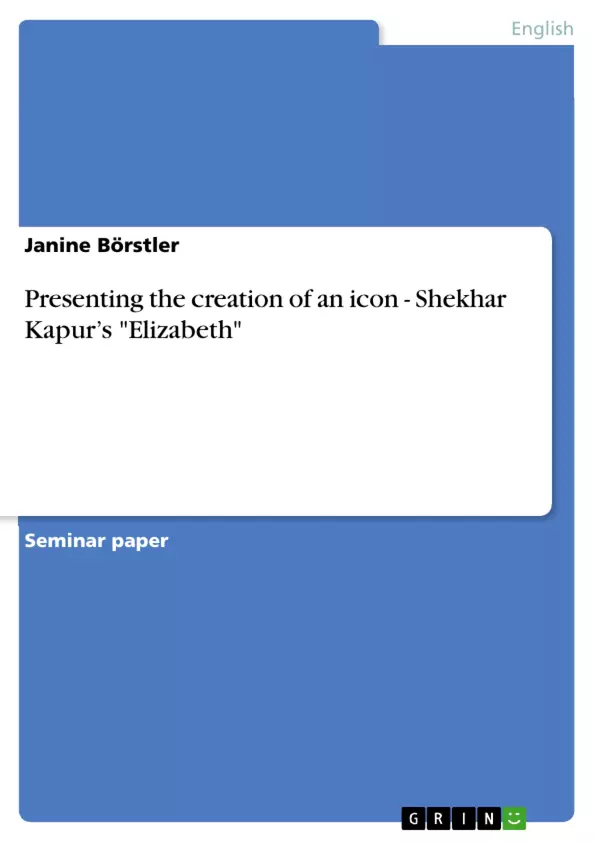When Shekhar Kapur is asked why he, as an Indian, made a film about Queen Elizabeth I, one of the most important rulers of England, the answer – as ever so often – might be that it was in his destiny. To make a film about culture that is so different from one’s own background requires a great deal of sensitivity. Yet history always depends on the interpretation of given facts and personal ideas always play a role in an interpretation. This could be one reason why Kapur’s Elizabeth and his interpretation of the queen’s development into the icon she is perceived as today, raised many voices of praise as well as criticism.
Elizabeth was an immediate success when it went on screen in 1998. Since then the film has been nominated for several awards and the ones that it received mostly valued the achievements of the director, the make-up artists and Cate Blanchett, who played the role of
Elizabeth I. Critics argued that the film “plays fast and loose with historical fact“ and the romance between Elizabeth and Robert Dudley is interpreted as reinforcement of “the idea of [Elizabeth] as a very weak and flighty character who often showed terrible judgment.”
The aim of this paper is to show that the development that Kapur’s Elizabeth goes through in the film is a preparation for the transition that takes places in the end. Relying on that, I would argue that the criticism about the mismatch of film and history in Kapur's Elizabeth is inappropriate.
To evaluate the validity of this thesis, relevant statements of the director and other persons that were involved in the making of the film shall be taken into consideration. Also the presentation of Elizabeth’s development in the film as such, especially concerning costumes and make-up, will be analysed. In the following the factors that Kapur suggest as reasons for Elizabeth’s change shall be examined and the director’s understanding of the concept surrounding the term ‘virginity’ will be clarified. Finally the results of this attempt to understand Kapur’s aims and his understanding of the development of the icon Elizabeth I. will be summarized in the conclusion.
Inhaltsverzeichnis (Table of Contents)
- Introduction
- Kapur's intentions
- Creating the icon of the,Virgin Queen'
- Filmic display of Elizabeth's development
- Reasons Kapur provides for the change
- The concept of virginity
- Conclusion
- Sources
Zielsetzung und Themenschwerpunkte (Objectives and Key Themes)
This paper aims to analyze the portrayal of Queen Elizabeth I's transformation into an icon in Shekhar Kapur's film "Elizabeth." The paper evaluates the film's narrative, focusing on the visual elements and director's intent to present a specific interpretation of Elizabeth's development.
- Interpretation of historical figures and events in film
- The creation of an icon through filmic techniques
- The portrayal of Elizabeth's emotional journey and its impact on her public persona
- The film's departure from historical accuracy and its focus on character development
- The director's understanding of "virginity" and its role in shaping Elizabeth's image
Zusammenfassung der Kapitel (Chapter Summaries)
- Introduction: This chapter introduces the film "Elizabeth" and its reception, highlighting the film's success and the critical debate surrounding its historical accuracy. The paper states its objective to analyze the development of Elizabeth I's iconography as depicted in the film.
- Kapur's intentions: This chapter delves into Shekhar Kapur's intentions in making "Elizabeth." It explores his desire to portray the creation of an icon rather than a historically accurate representation, highlighting his focus on Elizabeth's personal journey and the development of her public persona.
- Creating the icon of the,Virgin Queen': This chapter focuses on the film's depiction of Elizabeth's transformation into the "Virgin Queen." It examines how the film utilizes costumes, make-up, and storytelling to depict the stages of her development. The chapter also outlines the director's view on Elizabeth's personal struggles and how they influenced her public persona.
Schlüsselwörter (Keywords)
This preview focuses on the themes of icon creation, filmic interpretation of history, Elizabeth I's development as a ruler, and the director's understanding of "virginity" as a symbol in the film. The preview explores how these themes interact to shape the film's portrayal of Elizabeth I's transformation into a powerful and iconic figure.
- Arbeit zitieren
- Janine Börstler (Autor:in), 2010, Presenting the creation of an icon - Shekhar Kapur’s "Elizabeth", München, GRIN Verlag, https://www.grin.com/document/176043



